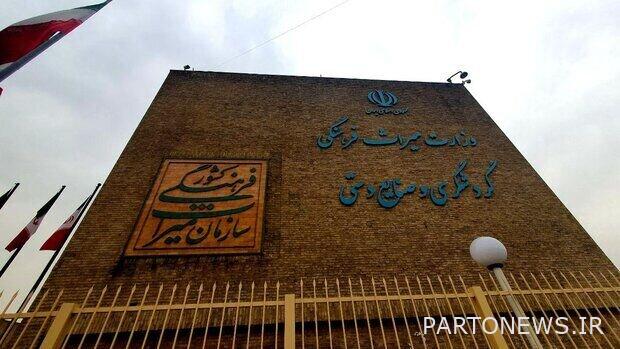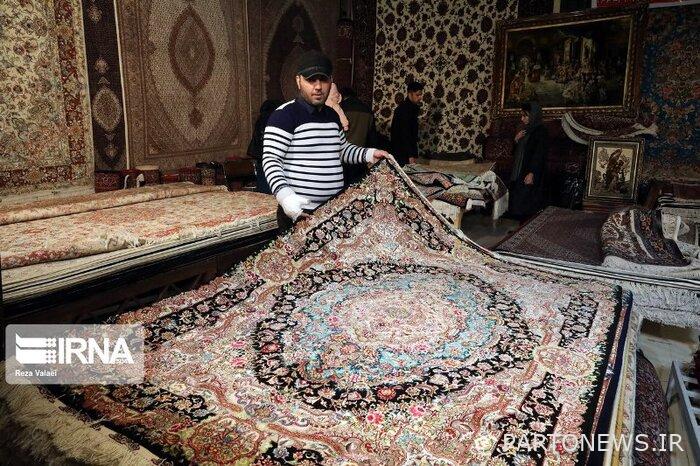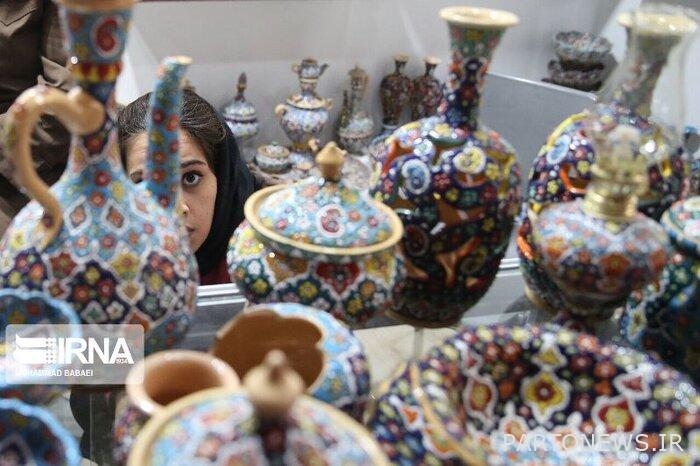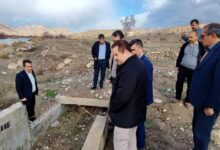The growth of handicrafts depends on youth trust, outsourcing and barriers

Producer and exporter of handicrafts and carpets, the growth of handicrafts, the economy of this field and the improvement of the conditions of the activists of this branch of art depend on trusting the elite youth, outsourcing affairs to the private sector and fulfilling obstacles as part of the Supreme Leader’s order. The thirteenth presidential election was held on the 28th of Khordad, 1400 AH, during which Dr. Seyyed Ibrahim Ra’isi was elected as the eighth President of the Islamic and Revolutionary Republic of Iran.
After the inauguration ceremony on the 14th of Mordad 1400, various whispers and talks about the election of the proposed ministers of the 13th government to win the vote of confidence by the Islamic Consultative Assembly, programs, approaches and challenges in various fields that the proposed ministers will face are the hottest headlines. And even had conversations with the general public.
Finally, the vote of confidence in the proposed ministers of the 13th cabinet began on Saturday (August 20, 1400) and on Wednesday (September 23) with the vote of confidence of 18 ministers out of 19 ministers proposed by the 13th president, structure, nature and executive structure. , Administrative and planning of the affairs of the country in all parts of the thirteenth government were identified.
However, before the start of the vote of confidence and in the final days leading up to this process, many experts, experts and stakeholders in various departments and related to each area of the ministry had published and expressed their views in the media; With the identification of the ministers and the publication of their plans, which have been based on the seats of their respective ministries since Thursday (September 25), the approach of expressing demands, requests, proposals and finally the expectations of stakeholders and activists in various fields has become more objective, tangible and transparent.
In the field of culture and art, the two Ministries of Islamic Culture and Guidance and Cultural Heritage, Tourism and Handicrafts are known as the two engines driving the extensive activities of the family of culture and art. Now that the helm of the two ministries has been determined in the hands of Dr. Mohammad Mehdi Esmaili and Engineer Seyed Ezatullah Zarghami, IRNA, in a conversation with stakeholders, activists, people of culture and art, is trying to make the ups and downs of their field of activity; Reflect the concerns and demands of these activists on the two elected ministers, their deputies and their directors.
In the first step, we went to Engineer Ali Badambarjah, one of the manufacturers and exporters of carpets and handicrafts. And we strengthened the strengths in both production and the economy of handicrafts.

The first demand is to lay the groundwork for the presentation of all handicraft products from luxury to economics
Ali Badambarjah, an exporter of carpets and handicrafts, said in an interview with IRNA cultural correspondent that he divides art and art products in all fields, including handicrafts and carpets, into two separate categories: “The first category belongs to luxury art and art products.” It is also known as productive art. It is an art that first introduces very special innovations in the field of art products to the residents and presents them in a very high form. The audience of this kind of artwork is a very special segment of society.
He cited an example to illustrate his point: “For example, in the art of inlay, we see a kind of luxurious inlay at a high level with expensive prices.” This is productive art. Art that in the field of production and presentation of its products, our elite, expert and first-rate artist creates innovations and innovations that make his product pure and unique.
The activist in the field of handicrafts and carpets pointed out: But the second category belongs to art and art products, which are called economic art. The art that enters the market. This art can be in the field of handicrafts, carpets or other goods, which may not have an extraordinary and unique quality, but it has such a good quality in the market that it can be offered to the general consumer of the society.
With this introduction, the first demand of the handicraft community for the prosperity of this field from the Minister of Cultural Heritage, Tourism and Handicrafts is to provide a suitable platform for the audience to achieve both that expensive art and economic art. This is one of the serious challenges of managers and management in the field of handicrafts that Mr. Zarghami is expected to think about and plan according to the initial plan, despite the years of demands of the people of the handicrafts of the country.
Officials should consider ways to revitalize the craft economy
Badambarjah, referring to the inclusion of handicrafts and art products in the general basket of culture and art of families, said: “When we say paintings, people’s minds should not be directed only to paintings worth one or several billion tomans.” In the balanced and comprehensive market of handicrafts or other art products, we can have a painting that is two or three million tomans and the general public can use it.
He stated: “Achieving this important requires bedding and planning that I mentioned. An issue that has remained a slogan for the last decade and has not found an operational aspect. Now, the activists and artists of the country’s handicrafts expect its implementation from the officials and custodians of the handicrafts field and its respective ministry at the top of this pyramid.
This exporter of samples of carpets and handicrafts derived from it, emphasizing that this example is true in its specialized sector, namely in the field of handicrafts and carpets, added: Is used. But there are also hand-woven carpets, the price of which is five to six million tomans per square meter, and it is cheaper to prepare it than a machine-made carpet for the general consumer.
He added: “If we separate these two parts from each other and we can have special programs for each of them with the range of audiences and their consumers in the form of the same platform; It can be very effective in revitalizing the handicraft economy.

Government support in the form of injecting money into the artist is the biggest blow to the artist and art products
“Let’s not forget that an art community that can’t stand on its own two feet is like a baby who always He is dependent on the help of his parents, and if this dependence is not removed, he will not be able to stand on his own two feet.
Now the question arises, what is the work of the government in the meantime? Instead of injecting money directly into the artist, the government, the Minister in charge of handicrafts, and his deputies spend the budget on productive and supportive platforms for artists such as research and development, advertising, and education. The shadow of these foundations and actions is that all artists and their products in the two categories of luxury and economic works can enter the market cycle, present their products to the consumer and even export their work in the field of currency more easily.
This producer of handicraft products and sample exporter emphasized: Another action of the government and statesmen in the field of prosperity of art economy and especially handicrafts as a lucrative industry, the profit of which, along with the benefit of producers and consumers, goes to the tax exemptions for the class. The artist and the provision of indirect facilities goes back to the handicraft artists.
He added: “Instead of injecting money directly into artists, providing facilities such as tax exemptions or electricity, water and gas payment facilities for handicraft workshops are among the most important steps a government can take to boost creative and lucrative industries in the arts sector.”

The government’s view of the private sector needs a revolutionary change
Badambarjah stated that in order for the private sector to grow and prosper in the field of artistic activities, we do not need change, but a revolution in the public sector: This revolution will not happen unless the private sector is seriously involved in decision-making, implementation and monitoring. Unlike some branches of artistic activity, we still do not see the presence of organized associations and unions in the field of handicrafts.
He lamented the lack of formation of such guilds and popular associations in the field of handicrafts in this regard, said: Although bitter, but it must be said that so far there is no need for the formation of such associations. Because the previous governments did not value the associations and guilds in the field of handicrafts so much that the activists in this field felt the need to establish such associations. Because no value has ever been given to the private sector or associations in the areas of decision-making, implementation and oversight, and the previous governments were in control of everything.
The manufacturer and exporter of samples of handicrafts and carpets regretted the existence of such a view and reminded the activists in this field: Why am I not an exporter to export my product which results in currency for the country to facilitate my affairs in customs? What kind of activity should I get help with? Or when he wants to hold a handicraft exhibition; Why shouldn’t the organizer of that exhibition be a carpet union or a union of handicrafts, which is composed of a body of experts in this field, aware of all the ups and downs and harms of this field, and all matters should be in the hands of the government.
He said: Wasn’t it a question of outsourcing and entrusting matters to specialists? Why didn’t all those professions find an executive and operational aspect and remain the same?
Fortunately, in the executive plan and Mr. Zarghami’s remarks as Minister of Cultural Heritage, Tourism and Handicrafts, there is an increase in the slope of executive affairs towards the private sector. If those programs are implemented, we will see the formation of strong associations and guilds in the field of handicrafts, which will result in empowering the decision-making process, implementation and supervision with the cooperation of the private sector or entrusting all matters to this sector and the superior supervision of the public sector. This is the same old dream.
The government should not be afraid to entrust matters to skilled and talented youth and should trust them
“We hear constantly that the private sector has not been able to show its effectiveness in trusting and entrusting itself with big things,” Badambarjah said. “The reason for this is clear; There has never been a basis for trusting them. In this private sector there are very strong educated youth with pure executive views who can be influential.
But in the first step, the government must have the courage to use these young people and not be afraid to give responsibility to these young people. In addition to this trust, the government should have excellent oversight, but the work, whether in decision-making, implementation or oversight, should be done entirely by the private sector. This is the secret of the evolution of the handicraft economy.
“In many countries around the world, this model of use has been very helpful to the government and profitable,” he said. “If we look at the Indian or Chinese model, we can see the importance of paying attention to the private sector.” China’s economic and popular handicraft exports are higher than our total oil and petrochemical exports. Why did this happen? The answer is simple. The answer lies in trusting the youth and the private sector. The combination of small and high-yield workshops and entrusting the competitive market, product variety and exports to the activists of this sector has brought such a huge result.
Referring to the slogan of the year and the Supreme Leader’s emphasis on the need for obstacles to the prosperity and prosperity of the country’s economy, he said: “If you want to build a small workshop in any sector, including handicraft production, thousands of issues with insurance, social security, tax administration It gets right in your way. While the realization of the slogan of providing facilities should be seen in such cases. Fortunately, the thirteenth government has entered the field with the same slogan, that is, revolutionary thinking in all sectors and attention to the youth, and we hope to see those words fulfilled in the executive form as well.
In the end, Badambarjah expressed his hope that at the beginning of the government in the Ministry of Cultural Heritage, Tourism and Handicrafts, we will see a purposeful look. The basis of what the Supreme Leader has emphasized in the slogan of the year is to increase their efforts more than ever.
Source: Aria Heritage

